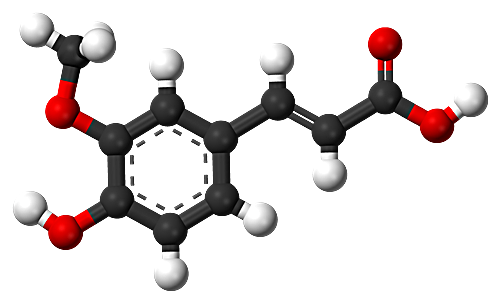
Ferulic acid is a hydroxycinnamic acid, which are a class of Aromatic acids or phenylpropanoids with a C6-C3 skeleton and are hydroxy derivatives of cinnamic acid. Ferulic acid is a kind of phenolic phytochemical, which exists in plant cell wall in a large amount. Ferulic acid is white or light brownish yellow crystalline powder with a mild pleasant odor.
Scientists at Creative Proteomics utilize a highly quantitative method with high-performance liquid chromatography (HPLC) for the determination of Ferulic Acid levels in various samples, including Plant, Blood and more. High-Performance Liquid Chromatography (HPLC) with UV detection is used for the determination of Ferulic acid (320 nm) levels in a lot of biological samples. This Methodology provides accurate, reliable, and reproducible results of Ferulic acid measurement, which enables us to analyze of Ferulic acid levels in vitro and in vivo.
Ferulic acid has strong antioxidant properties like many natural phenols that make it especially useful as free radicals such as reactive oxygen species(ROS). ROS is a natural byproduct of the normal metabolism of oxygen and has important roles in cell signaling and homeostasis, such as in DNA damage, cancer, and accelerated cell aging. There are some animal studies and in vitro studies have suggests that Ferulic acid may have pro-apoptotic effects in cancer cells thereby leading to cell death, especially have direct antitumor activity against breast cancer and liver cancer. Ancer induced by exposure to the carcinogenic compounds benzopyrene and 4-nitroquinoline 1-oxide can also be prevented by Ferulic acid according some studies. However, these studies are not involved in the human beings and these results of the antitumor activity induced by Ferulic acid are not directly applicable to human use.
The Russian-Polish botanist M. Tswett is generally recognized as the first person to establish the principles of chromatography. In a paper he presented in 1906, Tswett described how he filled a glass tube with chalk powder (CaCO3) and, by allowing an ether solution of chlorophyll to flow through the chalk, separated the chlorophyll into layers of different colors. He called this technique “chromatography”. Fundamentally, chromatography is a technique used to separate the components contained in a sample. High Performance Liquid Chromatography (HPLC) is a method able to separate non-volatile, thermally unstable, and polar components separate or in a mixture. HPLC is a type of chromatography that, because of its wide application range and quantitative accuracy, is regarded as an indispensable analytical technique, particularly in the field of organic chemistry. It is also widely used as a preparation technique for the isolation and purification of target components contained in mixtures.
Ferulic acid Analysis Service at Creative Proteomics supports your research in Ferulic acid Analysis. HPLC Based Analysis Service Platform enable us at Creative Proteomics offers you a state-of-the-art Analysis Service.
Sample Type
Plant, Blood and more
Method
High-Performance Liquid Chromatography (HPLC) with UV detection is used for the determination of Ferulic acid (320 nm) levels in a lot of biological samples. This Methodology provides accurate, reliable, and reproducible results of Ferulic acid measurement, which enables us to analyze of Ferulic acid levels in vitro and in vivo.
Send us your samples, you will get all information that you need!